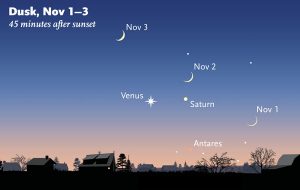Download our monthly astronomy podcast to track down Saturn in the evening sky one last time. Mars is still hanging around, and Venus is climbing higher each evening.

Sky & Telescope diagram
This is the last month you have a chance to spot Saturn. Look low in the west after sunset, and early in the month you'll find it to the right of brilliant Venus. By month's end it'll be gone.
Venus, meanwhile, is dramatically obvious and getting higher in the evening sky with each passing evening. It will be with us all wither long.
To the upper left of Venus, look for ruddy-colored Mars. Due an interesting geometric arrangement with its orbit, Mars won't be sinking as Saturn is, so we'll be able to enjoy it for several more weeks.
The Moon’s phases are almost exactly in sync with the calendar right now. So after sunset in early November you can watch it grow from a hair-thin crescent over in the west, to half-lit on the 7th, to full on the 14th. By the way, have you ever wondered why we call that half-lit phase “first quarter”? It has nothing to do with how the Moon looks. First quarter means that the Moon has completed one quarter of its orbit since the last new Moon. The same reasoning applies to “last quarter” two weeks later.
Geometrically, there's something noteworthy about the full (Beaver) Moon on the 14th. On that date at about 6 a.m. Eastern Time, the centers of the Earth and Moon will be just 221,524 miles apart. The Moon hasn’t been this close to Earth since 1948, and it won’t be this close again until 2034. the underlying reason is that the Moon’s orbit isn’t a perfect circle; it’s slightly elliptical, or oval shaped.So the Moon will be about 7% closer than average and its disk about 15% bigger in area.
For more skywatching tips for November, listen to or download our monthly astronomy podcast below.
Podcast: Play in new window | Download
Subscribe: Apple Podcasts | Google Podcasts | Spotify | Email | RSS | More
 1
1
Comments
Graham-Wolf
October 30, 2016 at 8:29 pm
Hi Kelly
Captured Venus at 400 ISO with a 10Mpx Canon A480 Compact Digi-camera, setting (2 nights ago), low in the West (NZDT). Exp ~ 1/4 second at f3.0 and 50mm efl. Used a 2s shutter delay to avoid shake, and set it up on a small hand-tripod on my brother's BBQ table, and Auto-Program feature. Two other "objects" either side came out in the exposure....3 for the price of one. It can be achieved. Great sky charts. Keep up the great work! Graham at 46 South, NZ
You must be logged in to post a comment.
You must be logged in to post a comment.